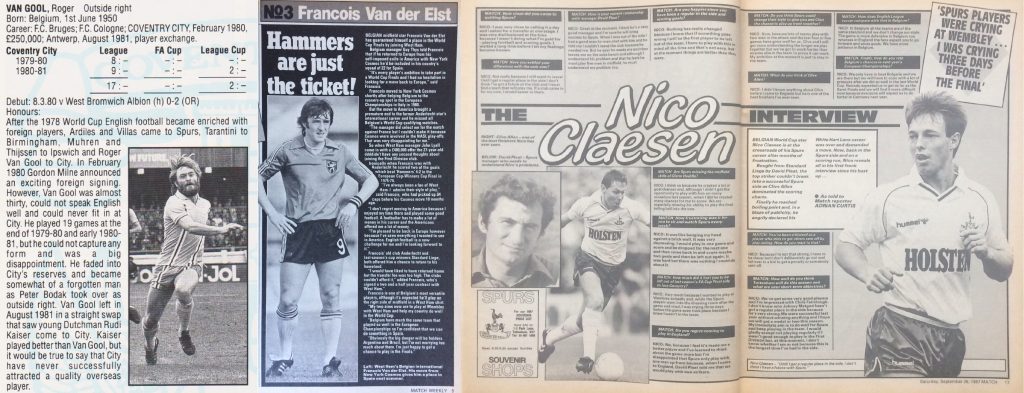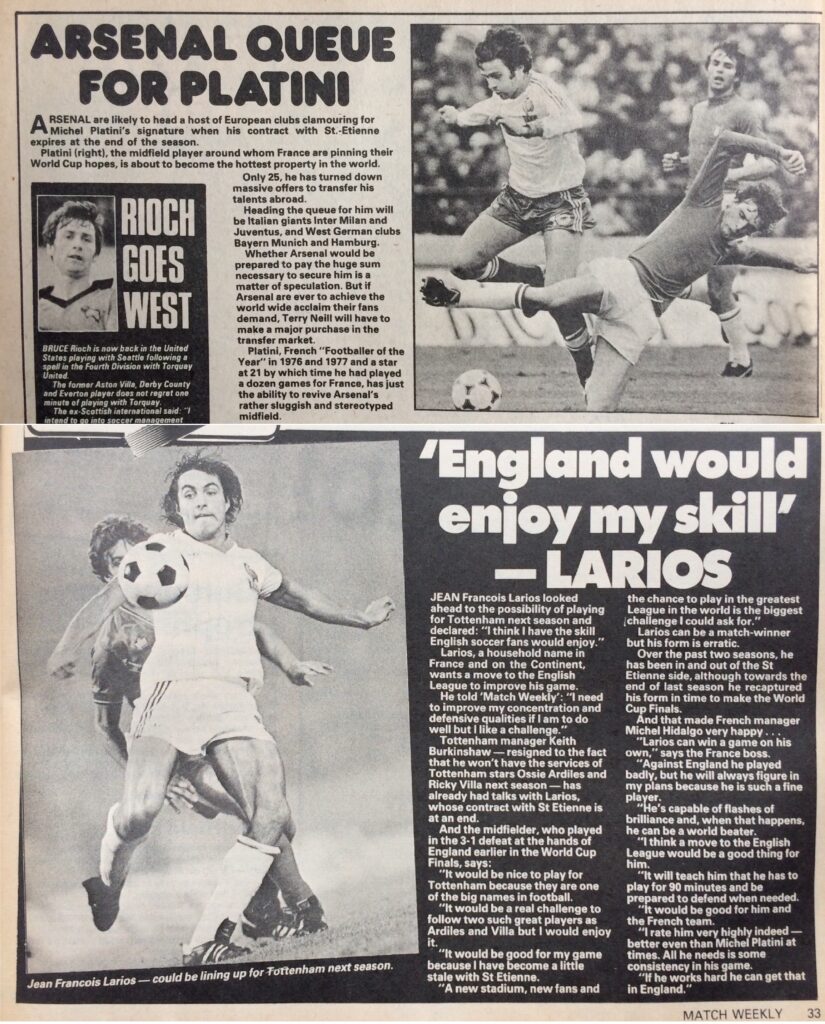Western Europe: Foreign Players in the Football League
As covered extensively, the bulk of players moving to the Football League post-1978 from Western Europe came from the Netherlands or Scandinavia and the Nordic nations. Other countries including the major footballing nations of France, (West) Germany, Italy and Spain were sparsely represented, with only rare exceptions. Most of the movement from the late 1970s and through the 80s was of top British players moving to those leagues (Kevin Keegan, Gary Lineker, Ian Rush, Glenn Hoddle and Chris Waddle).

While many Dutch players moved to England, surprisingly few followed from neighbours Belgium. Ike van den Eynden was the first Belgian in the Football League at Clapton Orient before the First World War, and Marcel Gaillard had been a pioneer at Crystal Palace in 1948, but it was only in 1980 that Roger van Gool was the next arrival, for a short stay at Coventry. He was followed by François van der Elst at West Ham and, later in the decade, Nico Claesen at Tottenham. All three players came with excellent reputations during a period when the Belgian national team was a major force in Europe, though none stayed long enough to show their full talent in England. Meanwhile moves for international striker Erwin Vandenbergh (by Birmingham, 1980) and goalkeeper Jean-Marie Pfaff (linked with Manchester United and Arsenal) never came to fruition.

Belgium: Roger van Gool, François van der Elst & Nico Claesen

There was a sporadic history of German players in the English game, beginning with Max Seeburg at Tottenham in 1907. After the Second World War, former prisoners of war Alec Eisenträger (at Bristol City) and, most famously, Bert Trautmann of Manchester City, made an impact in the Football League. Trautmann’s legacy of over 500 appearances included a heroic performance in the 1956 FA Cup Final, in which he played the last 15 minutes with a serious neck injury. In the same year he was voted Footballer of the Year, the first foreign player to win the award (not matched until 1981 by Dutchman Frans Thijssen). By the late 1970s, West Germany was one of the strongest European football nations and its domestic Bundesliga attracted players such as Kevin Keegan and Tony Woodcock; there were few German exports, and then usually to Italy rather than England.
One exception was midfielder Jürgen Röber, signed for Nottingham Forest by Brian Clough in 1981, when they were still a top European team. However Röber never established himself in a brief spell at the City Ground. Herbert Neumann was reportedly a target for Arsenal, but instead moved to Serie A. The next German arrivals were lower-profile and came later in the decade – striker Thomas Hauser at Sunderland, and Aston Villa duo Stefan Beinlich and Matthias Breitkreutz, who remained on the fringes of the first team.

Above – Western Europe: Raimondo Ponte (Swi), Matthias Breitkreutz (Ger) & Nayim (Spa); Below – Germany: Bert Trautmann, Eike Immel & Uwe Rösler, Manchester City

In an echo of Trautmann’s former glories, Manchester City signed several Germans during the 1990s: Uwe Rösler, Eike Immel, Steffen Karl, Maurizio Gaudino and Michael Frontzeck. Uwe Fuchs had spells at Middlesbrough and Millwall, but by far the most prominent German arrival in the early Premier League era was national team striker Jürgen Klinsmann. In the first of two spells with Spurs, he emulated Trautmann when he was voted Footballer of the Year in 1995.
Austria meanwhile provided no players to the Football League. While playmaker Herbert Prohaska was linked with Brighton at the start of the 1980s, defender Alex Sperr agreed a move from VOEST Linz to Aston Villa in 1989, only to be denied a work permit as he had not appeared for the national team. Goalkeeper Alex Manninger became the first Austrian to join an English club when he signed for Arsenal in 1997. Switzerland had a Football League representative fifty years earlier, when full-back Willi Steffen appeared for Chelsea as an amateur. In 1980 he was followed by Raimondo Ponte at Nottingham Forest, after the midfielder caught Brian Clough’s eye in European competition for Grasshoppers. His club and international team-mate André Egli also had a trial at the City Ground. Clough later revealed that he signed Ponte after a tentative approach for French superstar Michel Platini: “when I found out what his personal demands would be I soon lost interest.”

Above – Roger van Gool & Alex Sperr (R); Below – Raimondo Ponte & Jürgen Röber, Nottingham Forest

France had only ever supplied a couple of players to the Football League (Eugene Langenove of Walsall, 1922, and later Josef Praski of Notts County, 1949), while a number of Brits crossed the channel. The French national team were European Champions in 1984 and twice World Cup semi-finalists in the 1980s, while the domestic league continued to import from the Football League and beyond. There was speculation about not only Platini – strongly linked with Arsenal – but other stars of that generation moving to England, notably Marius Trésor (Forest) and Jean-François Larios (Spurs, 1982). Nothing became of these rumours, and it was therefore a major story when international winger Didier Six arrived at Aston Villa for an extended loan spell in 1984-85.
While Olivier Bernardeau spent 1986-87 at Chesterfield, the next import was more prominent: Eric Cantona was initially invited to train with Sheffield Wednesday in early 1992 but soon moved to Leeds, where he was the catalyst as they won the last First Division title. After controversially moving to Manchester United for £1 million in November 1992, Cantona went on to win four Premier League titles and establish himself as one of the biggest names in English football. His younger brother Joël meanwhile had a short spell at Stockport. Soon a stream of French internationals such as David Ginola at Newcastle were playing in England’s top division, many of them at Arsenal after Arsène Wenger’s ground-breaking appointment as manager in September 1996. Patrick Vieira, Nicolas Anelka, Emmanuel Petit, Thierry Henry and Robert Pires were just a handful of Wenger’s influential signings.

Above: Michel Platini & Jean-François Larios; Below: Olivier Bernardeau, Didier Six & Eric Cantona

The Spanish Civil War brought the first footballers from Spain to the Football League as young refugees. Several only played during wartime, but a handful led by Emilio Aldecoa at Coventry, and brothers José and Antonio Gallego (for Norwich and other clubs) made senior league appearances in the post-War years. Spain’s La Liga was another of Europe’s strongest in the 1980s, attracting British managers (including Howard Kendall, John Toshack and Terry Venables) and players such as Steve Archibald and Mark Hughes. Venables had signed Gary Lineker for Barcelona in 1986, and when he brought the England striker to Tottenham three years later, the first Spanish player since that distant era arrived with him. Mohamed Alí Amar, better known as Nayim, had been born in the Spanish enclave of Ceuta on the North African coast. A fringe player at Barcelona, he took time to establish himself in a four-season stay at Spurs which included the 1991 FA Cup win. His most famous moment came after returning to Spain with Real Zaragoza, when his long-range lob beat Arsenal’s David Seaman to win the 1995 European Cup Winners’ Cup Final.
In the summer of 1995, ambitious Wigan Athletic under new owner Dave Whelan brought three young Spanish players to England’s basement division. Predictably known as the ‘Three Amigos’, Roberto Martínez, Isidro Díaz and Jesús Seba signed from Real Zaragoza’s ‘B’ team to become the first Spaniards in England since Nayim. Martínez made the biggest impact, spending six seasons as a player before returning to Wigan as manager in 2009 and winning the 2013 FA Cup. He later managed Everton, Belgium in successive World Cups and currently Portugal.

Western Europe: Thomas Hauser (Ger), Nayim (Spa) & Andrea Silenzi (Ita)
An Italian connection with the Football League began with goalkeeper Rolando Ugolini, born in Italy but raised in Scotland, where he played a few games for Celtic before a nine-year stay at Middlesbrough from 1948. In the 1960s a handful of further Italian-born players were represented, most notably Manchester United’s Carlo Sartori and Giorgio Chinaglia at Swansea Town, before he went on to become an Italian international, Lazio legend and the NASL’s all-time leading scorer with the New York Cosmos. Italy had imposed its own ban on importing foreign players in the wake of the 1966 World Cup, which was only reversed in 1980. With Serie A then attracting the world’s best players throughout the 1980s, few Italians moved elsewhere, and none to the Football League. Instead, the likes of Liam Brady, Trevor Francis, Graeme Souness and Ray Wilkins were tempted to play in Italy. Giuliano Terraneo was one of the goalkeepers Manchester United were linked with under Alex Ferguson, but it was not until the Premier League era that Andrea Silenzi joined Nottingham Forest. Silenzi’s unhappy stay was followed by the successes of bigger names in Fabrizio Ravanelli, Gianluca Vialli, Benito Carbone and Gianfranco Zola.

Italy: Rolando Ugolini, Carlo Sartori & Giorgio Chinaglia
A scattering of other Western European nations were represented in the Football League – from Cyprus, Yılmaz Orhan was at West Ham (1976); Malta’s Joe Cini joined QPR for a spell in 1959, followed by John Buttigieg at Brentford in 1988. The Football League had its first players from Greece, Portugal and Turkey only after 1992 – Greece’s George Donis (Blackburn, 1996), Portugal’s José Dominguez (Birmingham, 1994) and Turkey’s Alpay (Aston Villa, 2000).

Western Europe: Yılmaz Orhan (Cyp), John Buttigieg (Mal) & José Dominguez (Por)
Several images courtesy of Miles McClagan (Flickr & @TheSkyStrikers) & Shahan Petrossian (Soccer Nostalgia).
The movement of players between the Football League and Western Europe is one of the topics discussed in my book Before the Premier League: A History of the Football League’s Last Decades.